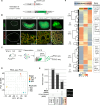FOXL2 interaction with different binding partners regulates the dynamics of ovarian development
- PMID: 38517962
- PMCID: PMC10959415
- DOI: 10.1126/sciadv.adl0788
FOXL2 interaction with different binding partners regulates the dynamics of ovarian development
Abstract
The transcription factor FOXL2 is required in ovarian somatic cells for female fertility. Differential timing of Foxl2 deletion, in embryonic versus adult mouse ovary, leads to distinctive outcomes, suggesting different roles across development. Here, we comprehensively investigated FOXL2's role through a multi-omics approach to characterize gene expression dynamics and chromatin accessibility changes, coupled with genome-wide identification of FOXL2 targets and on-chromatin interacting partners in somatic cells across ovarian development. We found that FOXL2 regulates more targets postnatally, through interaction with factors regulating primordial follicle formation and steroidogenesis. Deletion of one interactor, ubiquitin-specific protease 7 (Usp7), results in impairment of somatic cell differentiation, germ cell nest breakdown, and ovarian development, leading to sterility. Our datasets constitute a comprehensive resource for exploration of the molecular mechanisms of ovarian development and causes of female infertility.
Figures





References
-
- Migale R., Neumann M., Lovell-Badge R., Long-range regulation of key sex determination genes. Sex. Dev. 15, 360–380 (2022). - PubMed
-
- Koopman P., Gubbay J., Vivian N., Goodfellow P., Lovell-Badge R., Male development of chromosomally female mice transgenic for Sry. Nature 351, 117–121 (1991). - PubMed
-
- Hacker A., Capel B., Goodfellow P., Lovell-Badge R., Expression of Sry, the mouse sex determining gene. Development 121, 1603–1614 (1995). - PubMed
-
- Bullejos M., Koopman P., Spatially dynamic expression of Sry in mouse genital ridges. Dev. Dyn. 221, 201–205 (2001). - PubMed
-
- Vidal V. P., Chaboissier M. C., de Rooij D. G., Schedl A., Sox9 induces testis development in XX transgenic mice. Nat. Genet. 28, 216–217 (2001). - PubMed
Publication types
MeSH terms
Substances
Grants and funding
LinkOut - more resources
Full Text Sources
Molecular Biology Databases
Research Materials

